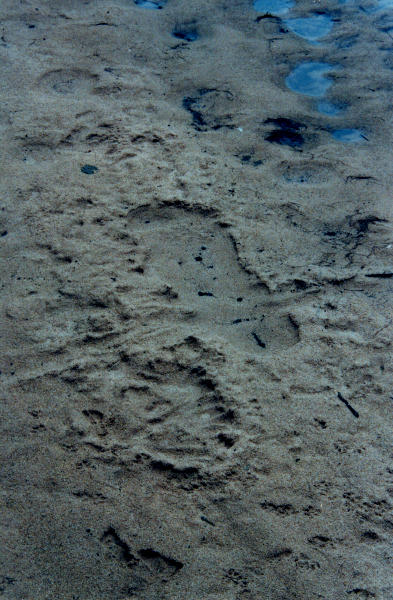If all the old bushmen’s’ yarns of encounters in the wild with the ‘hairy man’ that were so
commonplace throughout the 19th and early 20th centuries, none are more fascinating to relict
hominologists than those involving so-called “hairy giants”.
Indeed Aboriginal folklore concerning the “hairy man” [which can get confusing at times]
speaks of two forms of Yowie/Homo erectus; namely the “hairy man” and the “giant hairy man”.
It
appears that, to their way of thinking, any Yowie of around 2.6m and over is a “giant hairy man”. Yet a
comparison of the average size ‘modern’ foot of a Yowie/Homo erectus is smaller compared to the
large footprints of the 2.6-2.8m tall form, although both are dwarfed by the massive tracks laid down by
the true giants of the Australian bush, the “giant hairy man” proper.
These beings leave footprints [allowing for size distortion in sand etc] of from 90cm to 1m in
length with a width of from 40 to 45cm or more. A comparison of footprints of all three forms
revealed differences to the Gilroys in 2000 which we realised that everyone else had overlooked. The
2.6m form could not be younger members of the giant form, whom we judged to stand at least 3.66m
[12ft] in height and of powerful muscular build.
Therefore, like any scientist naming a newly discovered
species, we named this giant hominid ‘Rexbeast’. What follows are accounts of these giants, who in past ages must have roamed a far wider
domain, when the interior was a lush environment in Ice-Age times.
Today they are said by our
Aboriginal people to inhabit the vast interior of Australia’s eastern mountain ranges, and it was in these
ranges that 19th century settlers were warned by the old tribespeople that they should never go, lest they
would be caught, killed and eaten by the “giant hairy people”!
For Heather and I our first encounter with one of these giant beings took place during our
October-November 2000 south-eastern New South Wales Yowie field expedition.
‘Rexbeast’.
On Thursday 2nd
November, early that overcast morning we were driving inland from Bodalla on our way to the Deua
National park, when we crossed over the 3m high Eurobodalla bridge on the Tuross River. As I
happened to look down at a sandbar on my [passenger’s] side I spotted, deeply embedded in the sand, a
huge hominid foot impression. Pulling up on the north bank we walked back to the bridge’s centre, below which was the sand
bar containing the huge footprint. The Tuross River is tidal, so that when the tide is out, the river
hereabouts virtually dries up, exposing its sandy bottom in many areas, particularly at this spot. Below
the bridge the sandbar was 9 metres or so in width by just over 18 metres length, the bridge cutting
across its centre, with river water flowing eastwards to the sea.
We could clearly see the track of a pushbike, made by a rider when pedalling over the moist
sand the previous afternoon. There were also faint signs of children’s footprints and scratching around
the bike tracks and a huge [right] foot impression, almost obliterated by the rising tide the night before.
We could still faintly detect a trail of enormous footprints beneath the shallow water on the north side
of the sandbar. The evidence suggested to us that children had been playing on the dried-up river bed, leaving
the scene before dark, after which the monstrous hominid [surely a male] had emerged from nearby
forest country to cross open farmland, entering the river on its north bank, then strode across the sand
on a north-west to south-east course for some 30 metres to stop at the base of the 3 metre high bridge,
then turn directly west. At this point this massive right foot had covered the bike track. Subsequently
the tide had returned to cover or wash away most of the footprints but for what remained on this
sandbar, which by the time we appeared on the scene, had become an island surrounded by
[outflowing] water.
But how big was the maker of the monstrous foot impression? The distances between the
dozen or so almost obliterated [submerged] footprints showed a stride of about 1.8m. The foot
impression, allowing for distortion, measured 1 metre long by 40cm wide across the toes and 35cm
wide at the heel, its depth being up to 5cm; all of which suggested an individual of at least 4.6 metres in height and of powerful build and strength.
|

The Giant Foot Impression |
Rex Gilroy
Australian Yowie Research Centre,
Katoomba, NSW
Monday 25th June 2007







